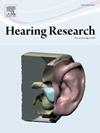声音耐受能力下降的神经化学:恐音症和听觉亢进的磁共振波谱研究
IF 2.5
2区 医学
Q1 AUDIOLOGY & SPEECH-LANGUAGE PATHOLOGY
引用次数: 0
摘要
本研究检测了兴奋性和抑制性神经递质(分别为谷氨酸和GABA)在两个感兴趣的区域(听觉和岛叶皮层)和一个控制区域(视觉皮层)的浓度,以验证声音耐受性降低与皮层兴奋性增加(谷氨酸和/或GABA减少)有关的假设。恐音症(对特定声音的负面情绪反应)和听觉亢进(发现声音异常响亮)被单独考虑,并排除了关键的合并症(耳鸣、偏头痛、自闭症)。在听觉皮层使用MEGA-PRESS序列来优化GABA的检测。我们发现在任何区域的神经递质没有显著的组差异,预注册贝叶斯分析表明这些是敏感的零结果。这些发现反驳了声音耐受性下降与神经化学驱动的兴奋/抑制差异有关的观点。本文章由计算机程序翻译,如有差异,请以英文原文为准。
The neurochemistry of decreased sound tolerance: A magnetic resonance spectroscopy (MRS) study of misophonia and hyperacusis
This study examined the concentrations of excitatory and inhibitory neurotransmitters (glutamate and GABA respectively) in two regions of interest (auditory and insular cortices) and a control region (visual cortex) to test the hypothesis that decreased sound tolerance would be linked to increased cortical excitability (more glutamate and/or less GABA). Misophonia (negative emotional responses to specific sounds) and hyperacusis (finding sounds atypically loud) were separately considered and key comorbidities excluded (tinnitus, migraine, autism). A MEGA-PRESS sequence was used for auditory cortex to optimise the detection of GABA. We found no significant group differences in neurotransmitter in any region and pre-registered Bayesian analyses suggested that these are sensitive null results. These findings argue against the idea that decreased sound tolerances are linked to neurochemically-driven differences in excitation/inhibition.
求助全文
通过发布文献求助,成功后即可免费获取论文全文。
去求助
来源期刊

Hearing Research
医学-耳鼻喉科学
CiteScore
5.30
自引率
14.30%
发文量
163
审稿时长
75 days
期刊介绍:
The aim of the journal is to provide a forum for papers concerned with basic peripheral and central auditory mechanisms. Emphasis is on experimental and clinical studies, but theoretical and methodological papers will also be considered. The journal publishes original research papers, review and mini- review articles, rapid communications, method/protocol and perspective articles.
Papers submitted should deal with auditory anatomy, physiology, psychophysics, imaging, modeling and behavioural studies in animals and humans, as well as hearing aids and cochlear implants. Papers dealing with the vestibular system are also considered for publication. Papers on comparative aspects of hearing and on effects of drugs and environmental contaminants on hearing function will also be considered. Clinical papers will be accepted when they contribute to the understanding of normal and pathological hearing functions.
 求助内容:
求助内容: 应助结果提醒方式:
应助结果提醒方式:


